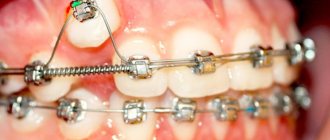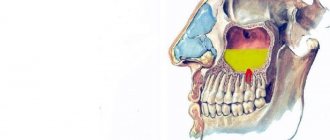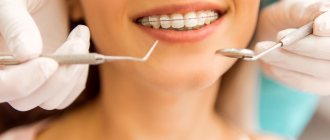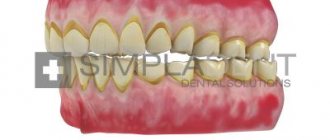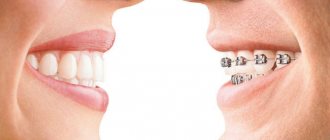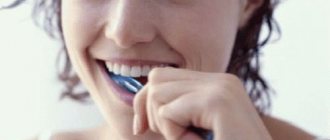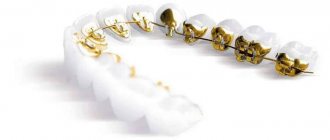27.11.2019
Patients often turn to dentists with malocclusions. To correct it, various methods are used, among which braces are especially popular. The question immediately arises: what is the name of the doctor who puts on braces? This is done by a specialist in a narrow field - an orthodontist, whose activities are very diverse.
Orthodontist – who is he?
Unfortunately, these days, not everyone understands who an orthodontist is and what he treats. Therefore, we will try to tell as much information about this specialist as possible.
Orthodontics is a very important dental specialty, because without it, excellent doctors would not be born, whose main purpose is to study the dental system, its structure and anomalies. What does an orthodontist do? He can assess the state of a person’s occlusion (the relationship of the dentition with each other), and if it is disturbed, find the most effective solution to the problem for the patient.
More than 80% of the world's population suffers from malocclusion1. However, most of us are not even aware of this, and only an orthodontist can identify the problem.
Malocclusion in a child
Bite pathologies occur for a variety of reasons: hereditary factors, intrauterine development disorders, artificial feeding, the formation of bad habits (pacifier and finger sucking in babies), calcium deficiency and poor nutrition. Premature or delayed removal of baby teeth can also cause developmental abnormalities.
So what problems can and should you see an orthodontist for? We present several of the most popular situations when the help of this doctor will be indispensable.
When should you see a doctor?
Let's consider the cases in which you need to see an orthodontist:
- If there are defects that spoil the aesthetic condition of the smile, the patient can voluntarily consult a doctor.
- In case of disorders of the dentofacial apparatus (for example, complications after prosthetics or tissue damage), a visit to the orthodontist is simply necessary.
- Formation of a deep bite.
- The lower jaw is positioned incorrectly.
- The presence of negative habits (speech deviations, the patient often sucks his finger, etc.).
- Curled teeth.
- Secondary malocclusion.
The services of an orthodontist can eliminate problems that interfere with prosthetics, or make it possible to avoid them.
An orthodontist also treats caries, periodontitis, periodontal disease and gingivitis.
Bite abnormalities in a baby
Who is an orthodontist? First of all, this is a specialist who can give parents useful recommendations on how to watch out for abnormal bite development in children. Keep in mind that a person’s bite is formed from birth until adolescence, up to 15-17 years. From 3 to 6 years it is temporary, up to 12 it is called replaceable, and only then a permanent one is formed. The sooner the problem is identified, the greater the chances your baby will have in adulthood to be proud of the beauty of his smile and not have any health problems.
In addition, in childhood, treatment becomes faster and easier. Therefore, an orthodontist is exactly the professional your child needs for dental health. The doctor will quickly get the baby’s bite in order. Be sure to visit it with your child.
First visit to the orthopedist
The first visit to an orthodontist should take place at the age of 3-4 years, when the child has fully erupted all of his baby teeth and some malocclusions are already visible. Treatment can begin at this age.
Description of structures that can correct the bite
Aligners or mouthguards are structures made of heavy-duty materials.
Advantages of aligners:
- Possibility to remove the structure;
- Made from discreet transparent material;
- Minimal discomfort when wearing;
- There is no need for special care (except for normal hygiene and rinsing with water).
Trainers are structures that are worn for several hours a day, depending on doctor’s orders. They are produced in series, which makes them affordable. Designed to correct minor changes in bite. With their help, it is good to align teeth that are located separately from each other.
Braces are small brackets connected by a power arc. Such designs are capable of correcting a large number of different deviations.
Note: They are worn depending on the initial curvature of the teeth and the body’s adaptation to changes, from two months to five years.
Bite problems in an adult
We all want our smile to look beautiful. After all, this is an external sign of attractiveness - it’s how we feel confident. If your teeth look ugly, then an orthodontist is a doctor who will definitely help correct the situation. It not only treats, but also eliminates the following external smile defects using individually selected designs:
- gaps between teeth,
- when the lower or upper jaw protrudes forward (mesial and distal bite),
- improper closing of the jaws,
- overlapping of teeth
- uneven, crooked, irregular shape of teeth and their location.
Malocclusion in an adult
Nowadays, not all people consider a beautiful smile a reason to be proud. In Japan, for example, crooked “aibu” teeth are considered the latest fashion. Young people pay any money for the sake of their deformation. For them, a mouthful of ugly teeth means being stylish and successful.
Stages of treatment by an orthodontist
At the beginning of treatment, the specialist conducts a diagnosis, which largely determines the final result.
The patient goes through the following stages:
- Visual inspection. The doctor studies the symmetry of the face, shape, profile and features of the oral cavity. An assessment is made of the general appearance of the teeth and jaws. The movement of the jaw and the closure of teeth are studied. The examination helps to identify how severely the bite is deformed and determine how difficult and long the treatment will be.
- An oral x-ray gives a general picture of the condition of the jaws and teeth. The image shows features that may not be noticed during normal examination.
- Making plaster models based on dental impressions taken. The model shows the location of the teeth, all the cusps and pits of the jaw. The specialist measures the necessary parameters and determines possible deviations. All features of the planned design must be taken into account at this stage.
Having determined the diagnosis, the specialist decides on a method to correct the problem:
- myotherapy - used only for small patients who are not allowed to have braces. Gymnastics of the jaws is carried out, during which children are given a correct bite that has not had time to form. The method cannot guarantee a 100% result. Gymnastics can also be used for adult patients when there are features that resist the use of other methods;
- hardware - used for patients of any age. For adults, the adjustment will take one to two years longer than for children. The procedure itself takes about an hour. The doctor installs braces, plates or aligners;
- surgical - used when there is no room in the mouth for teeth to grow or they are severely twisted.
Health problems due to malocclusion
Not many people realize that an orthodontist is also a person who, through treatment, can affect the overall health. The fact is that when the bite is disturbed, a number of very unpleasant and sometimes even dangerous processes begin to occur in the body:
- due to the incorrect location of some teeth, the rest may suffer, because they bear a heavy load, leading to wear and abrasion of the enamel, increased sensitivity, premature destruction,
- with malocclusion, facial asymmetry occurs, the functioning of the temporomandibular joint is disrupted, resulting in headaches, migraines,
- “wrong” teeth can injure the cheeks, lips, tongue, and other mucous membranes. Inflammatory processes cannot be excluded here,
- deterioration in breathing, swallowing and apnea, various speech defects,
- discomfort when chewing food and limited chewing function lead to diseases of the gastrointestinal tract, indigestion, and ulcers.
Incorrect positioning of teeth
Now do you understand how important it is to consult a specialist in a timely manner? An orthodontist is the one who will correct the bite and thereby help get rid of the consequences of a malocclusion - that’s for sure.
Even if you do not experience significant problems with your bite, be sure to visit a doctor. If you have hidden malocclusions, the orthodontist can easily determine this during the first visual examination and prescribe corrective treatment.
What to do if the bracket comes off?
In itself, this happens quite rarely, only in cases of severe crowding of teeth, since the arch puts a lot of pressure on the dentition and the lock falls off. Another option is if the patient is a nut or other solid food lover.
If you find a broken bracket, contact your orthodontist immediately. Otherwise, the teeth will begin to gradually move to their original position. Also remove elastic bands if you wear them.
The doctor sees patients with unstuck braces out of turn. It takes about 5 minutes to glue a new lock.
It also happens that the archwire flies out of the bracket grooves. You can try to get it back yourself. However, this should be done extremely carefully, without damaging the adjacent locks.
Need to choose an orthodontic device
Now you understand who an orthodontist is. This is a dentist who treats everything related to malocclusions. In some particularly severe cases, it is even necessary to resort to surgical procedures. For example, with abnormalities in the position of the jaws, or if there is not enough space for normal growth and functioning of the teeth. Sometimes teeth that interfere with bite correction are removed. In this case, an oral and maxillofacial surgeon comes to the rescue.
But the orthodontist offers methods of conservative treatment - these are braces, mouthguards, trainers. Children are often prescribed gymnastics or myotherapy - but it is effective only in the very early stages of correcting pathologies.
Selection of orthodontic apparatus
When choosing an orthodontist, it is very important to pay attention to his professionalism, availability of certificates, including in the field of taking various courses and advanced training. The doctor must ideally know the structure of the jaw system so that during correction the teeth take the correct position and do not move in completely different directions.
Now you know exactly why you need an orthodontist. This doctor will diagnose malocclusion, tell you about the possible consequences, even if there are no problems now, choose the optimal device and monitor the entire treatment process.
Notice
: Undefined variable: post_id in
/home/c/ch75405/public_html/wp-content/themes/UltraSmile/single-item.php
on line
45 Notice
: Undefined variable: full in
/home/c/ch75405/public_html/wp-content /themes/UltraSmile/single-item.php
on line
46
Rate this article:
( 1 ratings, average: 5.00 out of 5)
malocclusion
- Orekhova L.Yu. Periodontal diseases. Poly Media Press, 2004
Consulting specialist
Zilberman Tatyana Venyaminovna
Doctor rating: 9.3 out of 10 (3) Specialization: Orthodontist Experience: 24 years
The need to tighten braces
When using this type of bite correction, the teeth move into the correct position. This is a rather long and painful process. The braces are secured using a special arch, which must be periodically tightened as the teeth move. This is also done by an orthodontist who installs the braces system.
How often to tighten the metal arch depends on the degree of curvature of the patient’s teeth and is determined individually. On average, this procedure is performed once every few months; a doctor called an orthodontist will help you determine the exact frequency of visits. This depends on the material from which the braces are made, the condition of the patient’s teeth and the total duration of the course of therapy.
It is not recommended to skip such visits, otherwise the effectiveness of braces will be significantly reduced. On average, correcting a bite takes 3 years or more, so you need to prepare for multiple visits to the doctor.
During braces tightening, a person may experience pain, and you need to be prepared for this. This process is associated with increased pressure on the teeth as they move. In some cases, doctors may prescribe local pain medications. If the arch is tightened incorrectly, discomfort may occur while talking or eating. In this case, you must inform the doctor who installed the braces.
Another prerequisite is oral care during treatment with such structures. It involves the use of special toothbrushes, toothpastes and mouth rinses. Your doctor will help you select the necessary medications; he will also explain how to brush your teeth while wearing braces.
Category Orthodontics Published by Mister stomatolog
Types of malocclusion
What a malocclusion looks like depends on the type of deformity. There are the following types of malocclusion:
- Distal or prognathic. Characterized by a significant displacement of the upper jaw forward relative to the lower jaw.
- Deep. In the normal position of the jaws, the upper incisors cover the lower ones by about a third. When deformed in the form of a deep bite, the upper teeth protrude above the lower teeth by more than half.
- Mesial. It is characterized by strong development of the lower jaw, while it is pushed forward more than the upper one.
- Cross. With this pathology, the teeth move relative to each other.
- Open. When closing, a gap remains between the front teeth of the upper and lower rows.
How to correct a malocclusion, you should consult an orthodontist. There are various methods to normalize the position of the dentition.
Look for reviews of the specialist
If earlier we relied on the opinions of relatives, friends and acquaintances, today we have the Internet at our disposal, where we can find reviews about almost every doctor. Of course, not all reviews should be trusted. It is better to look for real reviews on large specialized resources, where before publication the author must go through the authorization procedure and, if necessary, answer a number of questions from moderators. It is also recommended to look for reviews on social networks: if a clinic (and especially a doctor) has its own platform on a social network, this is quite a significant advantage.
Look not only for a doctor, but also for a clinic
The doctor is directly involved in the treatment, but the clinic pays him a salary, cooperates with manufacturers and provides its patients with a guarantee. A good clinic employs good doctors - this is a statement that has been tested over the years. Especially in order to make it easier for patients to choose and provide the most objective information about the level of clinics, Startsmile, with the support of Kommersant Publishing House, annually conducts a Rating of private dental clinics. Each dental practice is evaluated based on 240 different criteria, so patients can be confident that the top-ranked clinics provide the highest level of treatment and service.
Braces hurt the oral cavity, what should I do?
After installing braces, each patient receives wax for locks from the orthodontist. At the very beginning, it is worth applying it to the entire system, because the mucous membrane in the oral cavity is not yet accustomed to contact with foreign objects.
Abrasions and wounds heal very quickly. Their healing can be accelerated by using agents that promote the healing of wounds in the oral cavity.
When should you choose a clinic?
- You want to carry out several types of treatment in one clinic.
If you first need caries treatment, then bite correction, and then installation of veneers, implantation or whitening, loyalty to one clinic can help save more than one thousand rubles: many clinics have discount programs for regular patients. In addition, it will be more convenient to visit one medical institution.
Wholesale - often cheaper
- You are constantly running out of time.
Since correcting a bite is a rather expensive treatment, patients often choose a clinic that is not the most convenient, sometimes even in another city if the prices are lower there. Is it worth doing this? This is a controversial issue, since savings are not always justified over a long period of time. In addition, you will need money for travel. And if you can’t go to the clinic on the appointed day to activate the system or replace the aligners, the treatment process will stop until the next appointment. In any case, it is better for busy people to choose the clinic that is closer to home or work. This will help you avoid missing or rescheduling appointments. After all, for quick and successful treatment, it is important to visit the doctor strictly on the appointed dates.
It is much more profitable to use the installment program, which is now offered by almost all clinics. Payment in installments is available to most patients, and there is no need to try to save money, with the risk that the treatment process will suffer.
How to straighten teeth without braces
With age, bone and connective tissue become more rigid and more difficult to move in the desired direction. Therefore, in an adult, bite restoration has a number of features.
Traditional orthodontic treatment is braces, but for various reasons it is not suitable for everyone. These may be individual contraindications of the patient, special requirements for appearance and diction.
An alternative way to straighten teeth is to use aligners (aligners) - orthodontic structures made of safe medical plastic, the wearing of which is invisible to others.
Surgical correction of the bite is less commonly used - this method is indicated in the most difficult cases (severe open bite, traumatic violation of symmetry, hereditary defects).
In consultation with an orthodontist, you will choose the method by which teeth will be straightened, based on the clinical picture, recommendations, and cost of treatment.
Pay attention to the “before and after” work
Cases with solved clinical cases are the main portfolio of a doctor. As a rule, photographs with the stages of treatment are posted on the clinic’s website or on the doctor’s personal resource. When evaluating “before and after” work, it is important to find an example with a similar clinical case and evaluate the success of using a particular orthodontic system.

